Traffic Fines#
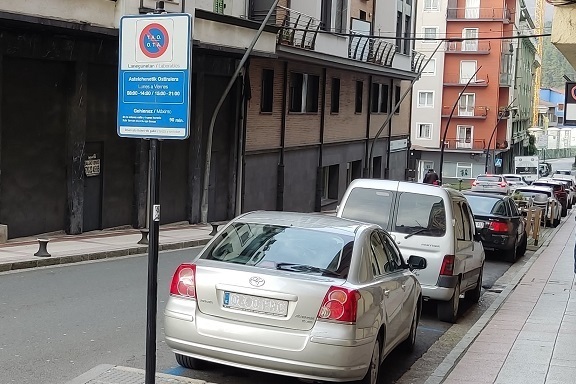
Jan, 2023
Open Data Choropleth maps
Background#
To make a data project, first you need data. One possibility is to collect it yourself, making it a quantifying project for a start. Another alternative is to directly ask for the data to the people who have it. And then, there is sometimes the option of downloading it from the internet as open data, which is what I did for this project.
I was curious about what the local government was publishing as open data. The datasets I found were not particularly exciting, much of it was about municipal finances and some demographics. But I came across the information of traffic fines during the last few years, and I thought I would give it a try.
With open data, institutions aim to become more transparent to the public. The data is shared, it is available for anyone to take a look at it, but usually it is not that simple. You need a data project to make sense of it. Once you convert the numbers into graphics and insightful information, only then the data comes alive and you can figure out what is going on.
The data#
I downloaded the CSV files from this link, containing traffic fines in my town from 2018 to 2022.
https://www.gipuzkoairekia.eus/
Show code cell source
# Import packages
import pandas as pd
import numpy as np
import matplotlib.pyplot as plt
import seaborn as sns
import geopandas as gpd
import contextily
from IPython.display import Markdown
# Read the data
usecols=[0, 4, 5, 6, 7, 8] # Useful columns
fines_2018 = pd.read_csv("data/multas_2018.csv", sep=";", decimal=",", usecols=usecols)
fines_2019 = pd.read_csv("data/multas_2019.csv", sep=";", decimal=",", usecols=usecols)
fines_2020 = pd.read_csv("data/multas_2020.csv", sep=";", decimal=",", usecols=usecols)
fines_2021 = pd.read_csv("data/multas_2021.csv", sep=";", decimal=",", usecols=usecols)
fines_2022 = pd.read_csv("data/multas_2022.csv", sep=";", decimal=",", usecols=usecols)
# Concatenate the data from different years into a unique dataset
fines = pd.concat([fines_2018, fines_2019, fines_2020, fines_2021, fines_2022])
# Rename columns
fines = fines.rename(columns={"AÑO": "year",
"NOMBRE CALLE": "street",
"CALIFICACION": "category",
"NRO MULTAS": "fines",
"IMPORTE PAGADO": "paid",
"IMPORTE PENDIENTE DE PAGO EN EJECUTIVA": "unpaid"})
print(fines)
year street category fines paid unpaid
0 2018 NaN LEVE 2 15.0 0.00
1 2018 GELTOKIEN ENPARANTZA GRAVE 3 0.0 234.95
2 2018 GELTOKIEN ENPARANTZA LEVE 52 640.8 279.15
3 2018 GELTOKIEN ENPARANTZA MUY GRAVE 2 500.0 0.00
4 2018 EUSKADI ENPARANTZA GRAVE 4 200.0 244.95
.. ... ... ... ... ... ...
75 2022 IBAIONDO GRAVE 2 200.0 0.00
76 2022 IBAIONDO LEVE 45 385.0 259.65
77 2022 ESKUALDEKO OSPITALEA GRAVE 34 2100.0 949.80
78 2022 ESKUALDEKO OSPITALEA LEVE 62 675.0 533.55
79 2022 ANTIO LEVE 1 0.0 0.00
[340 rows x 6 columns]
As shown in the dataframe above, the number of fines related to the year and street is already aggregated into three different categories:
LEVE, for mild traffic offences.
GRAVE, for serious ones.
MUY GRAVE, for very serious ones.
Data validation#
Data inspection shows some missing values.
Show code cell source
# Dataframe inspection
fines.info()
<class 'pandas.core.frame.DataFrame'>
Int64Index: 340 entries, 0 to 79
Data columns (total 6 columns):
# Column Non-Null Count Dtype
--- ------ -------------- -----
0 year 340 non-null int64
1 street 337 non-null object
2 category 340 non-null object
3 fines 340 non-null int64
4 paid 340 non-null float64
5 unpaid 340 non-null float64
dtypes: float64(2), int64(2), object(2)
memory usage: 18.6+ KB
Only 3 rows out of 340 have missing values, and with few fine quantities, so I just drop them.
Show code cell source
# Rows with NaN values
print(fines[fines["street"].isna()])
year street category fines paid unpaid
0 2018 NaN LEVE 2 15.0 0.0
0 2020 NaN MUY GRAVE 2 120.0 0.0
0 2021 NaN MUY GRAVE 1 0.0 0.0
Show code cell source
# Discard rows with NaN values
fines = fines[~fines["street"].isna()]
Show code cell source
# Check dataframe
fines.info()
<class 'pandas.core.frame.DataFrame'>
Int64Index: 337 entries, 1 to 79
Data columns (total 6 columns):
# Column Non-Null Count Dtype
--- ------ -------------- -----
0 year 337 non-null int64
1 street 337 non-null object
2 category 337 non-null object
3 fines 337 non-null int64
4 paid 337 non-null float64
5 unpaid 337 non-null float64
dtypes: float64(2), int64(2), object(2)
memory usage: 18.4+ KB
As data types are already correct, no further measures are needed.
Exploratory Data Analysis#
Fines by street#
QUESTION: Which are the streets with the greater number of fines? Locate the hotspots.
Show code cell source
# Group by streets and fine category, then sum up fines
fines_streets = fines.groupby(["street", "category"])["fines"].sum().unstack()
# Rearrange column order: LEVE, GRAVE, MUY GRAVE
fines_streets = fines_streets.iloc[:, [1, 0, 2]]
# Create new column with the total amount of fines: LEVE + GRAVE + MUY GRAVE
fines_streets["total"] = fines_streets.sum(axis=1)
# Sort values by total amount of fines
fines_streets = fines_streets.sort_values("total", ascending=False)
print(fines_streets)
category LEVE GRAVE MUY GRAVE total
street
ZELAI-ARIZTI PARKEA 916.0 2.0 NaN 918.0
SEKUNDINO ESNAOLA KALEA 619.0 29.0 2.0 650.0
ESKUALDEKO OSPITALEA 422.0 165.0 NaN 587.0
GELTOKIEN ENPARANTZA 504.0 21.0 6.0 531.0
PIEDAD KALEA 429.0 32.0 1.0 462.0
BIDEZAR KALEA 352.0 25.0 NaN 377.0
KALEBARREN 269.0 25.0 NaN 294.0
ELIZKALE 202.0 49.0 3.0 254.0
SAN GREGORIO KALEA 169.0 21.0 3.0 193.0
LEGAZPI KALEA 167.0 6.0 NaN 173.0
ELKANO KALEA 143.0 22.0 1.0 166.0
EUSKADI ENPARANTZA 137.0 12.0 NaN 149.0
URDANETA HIRIBIDEA 122.0 21.0 1.0 144.0
JAI-ALAI KALEA 123.0 6.0 NaN 129.0
ESTEBAN ORBEGOZO IBILALDIA 101.0 15.0 NaN 116.0
LETURIATARREN ENPARANTZA 80.0 29.0 1.0 110.0
IPARRAGIRRE HIRIBIDEA 35.0 59.0 3.0 97.0
SORALUCE KALEA 85.0 NaN NaN 85.0
OKENDO KALEA 67.0 12.0 NaN 79.0
TXURRUKA KALEA 70.0 4.0 1.0 75.0
IBAIONDO 58.0 8.0 NaN 66.0
ARTIZ AUZOA 57.0 6.0 1.0 64.0
EUSKALERRIA HIRIBIDEA 29.0 33.0 1.0 63.0
ANTONINO ORAA KALEA 42.0 14.0 NaN 56.0
UROLA KALEA 28.0 16.0 NaN 44.0
BELOKI HIRIBIDEA 28.0 13.0 1.0 42.0
IÑIGO DE LOIOLA KALEA 25.0 11.0 NaN 36.0
BUSKA SAGASTIZABAL PARKEA 24.0 6.0 NaN 30.0
ETXEBERRI AUZOA 25.0 3.0 1.0 29.0
ISLAS FILIPINAS KALEA 7.0 11.0 NaN 18.0
ANTIO 12.0 3.0 NaN 15.0
IPAR HAIZEA AUZOA 12.0 2.0 NaN 14.0
IZAZPI AUZOA 4.0 7.0 1.0 12.0
ANTZIÑE HIRIBIDEA 5.0 6.0 NaN 11.0
LEGAZPI AUZUNEA 9.0 NaN NaN 9.0
SAN ISIDRO KALEA 5.0 4.0 NaN 9.0
NAFARROA ENPARANTZA 6.0 NaN NaN 6.0
SAKABANATUAK 1.0 5.0 NaN 6.0
JOXE MIEL BARANDIARAN AUZUNEA NaN 4.0 1.0 5.0
URTUBI AUZOA 4.0 1.0 NaN 5.0
HIRI LORATEGIA 1.0 4.0 NaN 5.0
ELGARRESTAMENDI KALEA NaN 4.0 NaN 4.0
ARGIXAO AUZOA 3.0 1.0 NaN 4.0
ZUMARRAGAKO INDUSTRIALDEA 1.0 1.0 NaN 2.0
EITZA BERRI 2.0 NaN NaN 2.0
ANGEL CRUZ JAKA AUZUNEA NaN NaN 1.0 1.0
Show code cell source
# Define color palette
palette = ["tab:blue", "tab:orange", "tab:red"]
# Plot
fig, ax = plt.subplots(figsize=(8, 12))
fines_streets.sort_values("total").drop("total", axis=1).plot(ax=ax, kind="barh",
stacked=True, color=palette)
ax.grid(axis="x")
ax.set_axisbelow(True)
ax.set_title("Number of fines 2018-2022", size=11)
ax.set_xlabel("# of fines", fontsize=11)
ax.set_ylabel("")
ax.legend(fontsize=11, loc='center')
sns.despine()
plt.show()
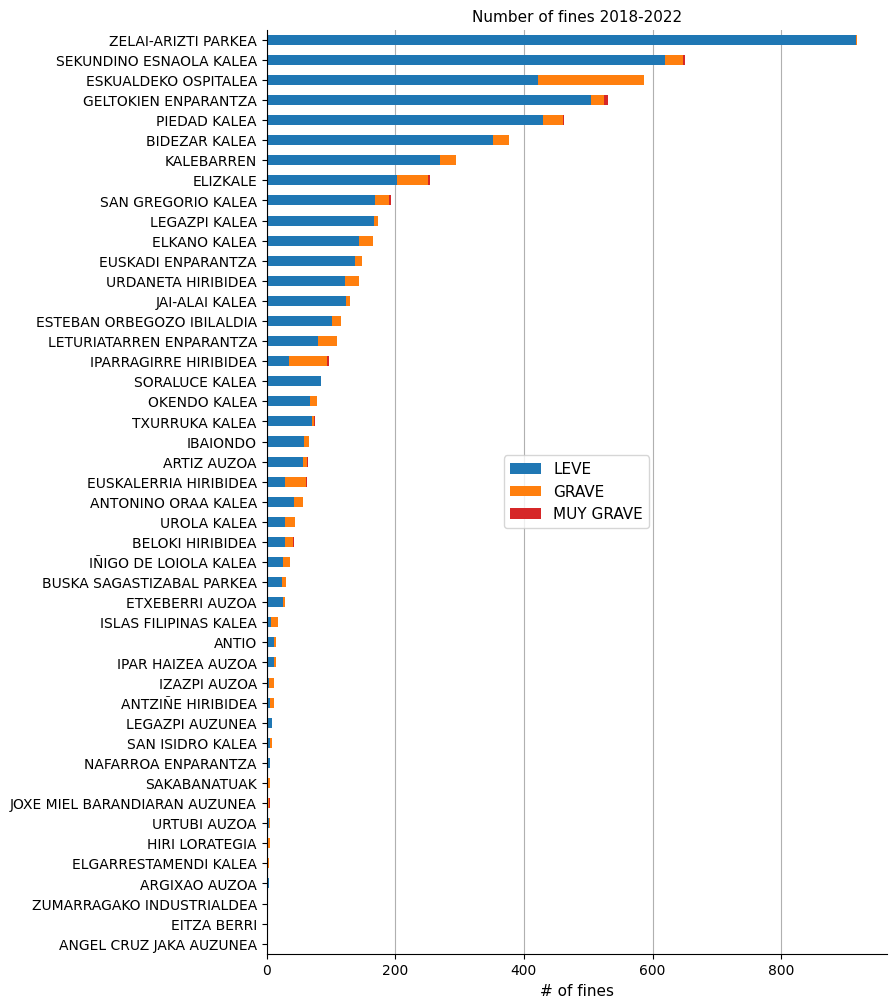
I decided to put this information into a choropleth. That for, I first needed to form a map with the streets and neighborhoods of the town. I draw each polygon by hand using https://geojson.io/.
Show code cell source
# Read geographical data of streets into a geopandas dataframe
zelai = gpd.read_file("geojson/zelai_arizti_parkea.geojson")
zelai["street"] = "ZELAI-ARIZTI PARKEA"
sekundino = gpd.read_file("geojson/sekundino_esnaola_kalea.geojson")
sekundino["street"] = "SEKUNDINO ESNAOLA KALEA"
ospitalea = gpd.read_file("geojson/eskualdeko_ospitalea.geojson")
ospitalea["street"] = "ESKUALDEKO OSPITALEA"
geltokien = gpd.read_file("geojson/geltokien_enparantza.geojson")
geltokien["street"] = "GELTOKIEN ENPARANTZA"
piedad = gpd.read_file("geojson/piedad_kalea.geojson")
piedad["street"] = "PIEDAD KALEA"
bidezar = gpd.read_file("geojson/bidezar_kalea.geojson")
bidezar["street"] = "BIDEZAR KALEA"
kalebarren = gpd.read_file("geojson/kalebarren.geojson")
kalebarren["street"] = "KALEBARREN"
elizkale = gpd.read_file("geojson/elizkale.geojson")
elizkale["street"] = "ELIZKALE"
gregorio = gpd.read_file("geojson/san_gregorio_kalea.geojson")
gregorio["street"] = "SAN GREGORIO KALEA"
legazpi = gpd.read_file("geojson/legazpi_kalea.geojson")
legazpi["street"] = "LEGAZPI KALEA"
elkano = gpd.read_file("geojson/elkano_kalea.geojson")
elkano["street"] = "ELKANO KALEA"
euskadi = gpd.read_file("geojson/euskadi_enparantza.geojson")
euskadi["street"] = "EUSKADI ENPARANTZA"
urdaneta = gpd.read_file("geojson/urdaneta_hiribidea.geojson")
urdaneta["street"] = "URDANETA HIRIBIDEA"
jai = gpd.read_file("geojson/jai_alai_kalea.geojson")
jai["street"] = "JAI-ALAI KALEA"
orbegozo = gpd.read_file("geojson/esteban_orbegozo_ibilaldia.geojson")
orbegozo["street"] = "ESTEBAN ORBEGOZO IBILALDIA"
leturia = gpd.read_file("geojson/leturiatarren_enparantza.geojson")
leturia["street"] = "LETURIATARREN ENPARANTZA"
iparragirre = gpd.read_file("geojson/iparragirre_hiribidea.geojson")
iparragirre["street"] = "IPARRAGIRRE HIRIBIDEA"
soraluze = gpd.read_file("geojson/soraluze_kalea.geojson")
soraluze["street"] = "SORALUZE KALEA"
okendo = gpd.read_file("geojson/okendo_kalea.geojson")
okendo["street"] = "OKENDO KALEA"
txurruka = gpd.read_file("geojson/txurruka_kalea.geojson")
txurruka["street"] = "TXURRUKA KALEA"
ibaiondo = gpd.read_file("geojson/ibaiondo.geojson")
ibaiondo["street"] = "IBAIONDO"
artiz = gpd.read_file("geojson/artiz_auzoa.geojson")
artiz["street"] = "ARTIZ AUZOA"
euskalerria = gpd.read_file("geojson/euskalerria_hiribidea.geojson")
euskalerria["street"] = "EUSKALERRIA HIRIBIDEA"
oraa = gpd.read_file("geojson/antonino_oraa_kalea.geojson")
oraa["street"] = "ANTONINO ORAA KALEA"
urola = gpd.read_file("geojson/urola_kalea.geojson")
urola["street"] = "UROLA KALEA"
beloki = gpd.read_file("geojson/beloki_hiribidea.geojson")
beloki["street"] = "BELOKI HIRIBIDEA"
loiola = gpd.read_file("geojson/inigo_de_loiola_kalea.geojson")
loiola["street"] = "IÑIGO DE LOIOLA KALEA"
busca = gpd.read_file("geojson/busca_sagastizabal_parkea.geojson")
busca["street"] = "BUSCA SAGASTIZABAL PARKEA"
etxeberri = gpd.read_file("geojson/etxeberri_auzoa.geojson")
etxeberri["street"] = "ETXEBERRI AUZOA"
filipinas = gpd.read_file("geojson/islas_filipinas_kalea.geojson")
filipinas["street"] = "ISLAS FILIPINAS KALEA"
antio = gpd.read_file("geojson/antio.geojson")
antio["street"] = "ANTIO"
ipar = gpd.read_file("geojson/ipar_haizea_auzoa.geojson")
ipar["street"] = "IPAR HAIZEA AUZOA"
izazpi = gpd.read_file("geojson/izazpi_auzoa.geojson")
izazpi["street"] = "IZAZPI AUZOA"
antzine = gpd.read_file("geojson/antzine_hiribidea.geojson")
antzine["street"] = "ANTZIÑE HIRIBIDEA"
legazpi_auzo = gpd.read_file("geojson/legazpi_auzunea.geojson")
legazpi_auzo["street"] = "LEGAZPI AUZUNEA"
isidro = gpd.read_file("geojson/san_isidro_kalea.geojson")
isidro["street"] = "SAN ISIDRO KALEA"
nafarroa = gpd.read_file("geojson/nafarroa_enparantza.geojson")
nafarroa["street"] = "NAFARROA ENPARANTZA"
barandi = gpd.read_file("geojson/joxe_miel_barandiaran_auzunea.geojson")
barandi["street"] = "JOXE MIEL BARANDIARAN AUZUNEA"
urtubi = gpd.read_file("geojson/urtubi_auzoa.geojson")
urtubi["street"] = "URTUBI AUZOA"
lorategia = gpd.read_file("geojson/hiri_lorategia.geojson")
lorategia["street"] = "HIRI LORATEGIA"
elgarrestamendi = gpd.read_file("geojson/elgarrestamendi_kalea.geojson")
elgarrestamendi["street"] = "ELGARRESTAMENDI KALEA"
argixao = gpd.read_file("geojson/argixao_auzoa.geojson")
argixao["street"] = "ARGIXAO AUZOA"
industrialdea = gpd.read_file("geojson/zumarragako_industrialdea.geojson")
industrialdea["street"] = "ZUMARRAGAKO INDUSTRIALDEA"
eitza = gpd.read_file("geojson/eitza_berri.geojson")
eitza["street"] = "EITZA BERRI"
jaka = gpd.read_file("geojson/anjel_cruz_jaka_auzunea.geojson")
jaka["street"] = "ANGEL CRUZ JAKA AUZUNEA"
# Concatenate all dataframes into a unique one
zumarraga = pd.concat([zelai, sekundino, ospitalea, geltokien, piedad, bidezar,
kalebarren, elizkale, gregorio, legazpi, elkano, euskadi,
urdaneta, jai, orbegozo, leturia, iparragirre, soraluze,
okendo, txurruka, ibaiondo, artiz, euskalerria, oraa,
urola, beloki, loiola, busca, filipinas, antio, ipar,
izazpi, antzine, legazpi_auzo, isidro, nafarroa, barandi,
urtubi, lorategia, elgarrestamendi, argixao,
industrialdea, eitza, jaka,
# etxeberri,
])
# Create a projected reference system to plot with a basemap
zumarraga_3857 = zumarraga.copy()
zumarraga_3857.geometry = zumarraga_3857.geometry.to_crs(epsg=3857)
# Plot with a basemap
fig, ax = plt.subplots()
legend_kwds = {'title': 'Streets & neighbourhoods', 'fontsize': 8,
'loc': 'upper left', 'bbox_to_anchor': (1, 1.03), 'ncol': 2}
zumarraga_3857.plot(ax=ax, column="street", legend=True, legend_kwds=legend_kwds)
contextily.add_basemap(ax,
source=contextily.providers.OpenStreetMap.Mapnik,
# source=contextily.providers.CartoDB.PositronNoLabels,
)
ax.set_axis_off()
plt.show()
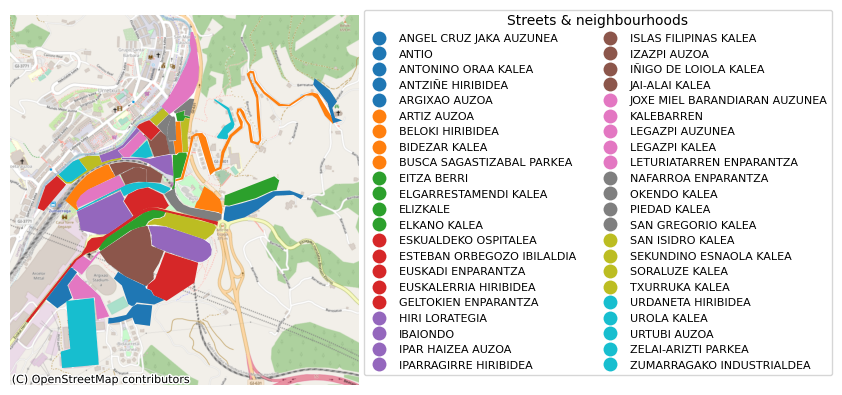
Having made the map, it was all about merging it with the fines dataframe to get the couple of choropleths shown below.
Show code cell source
# Merge geographical dataframe with fine by streets dataframe
zumarraga_fines = zumarraga.merge(fines_streets, how="left",
left_on="street", right_on=fines_streets.index)
# Plot a choropleth by total number of fines
fig, ax = plt.subplots()
zumarraga_fines.plot(ax=ax, column="total", legend=True, cmap="Greys",
legend_kwds={'label': "# of fines", "shrink": 0.7})
ax.set_title("Neighborhoods by TOTAL number of fines", size=11)
ax.set_axis_off()
plt.show()
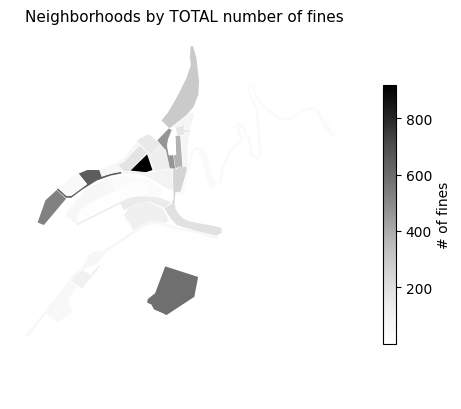
Show code cell source
# Plot a choropleth by total number of serious (GRAVE) fines
fig, ax = plt.subplots()
zumarraga_fines.plot(ax=ax, column="GRAVE", legend=True, cmap="Oranges",
legend_kwds={'label': "# of fines", "shrink": 0.7})
ax.set_title("Neighborhoods by serious 'GRAVE' number of fines", size=11)
ax.set_axis_off()
plt.show()
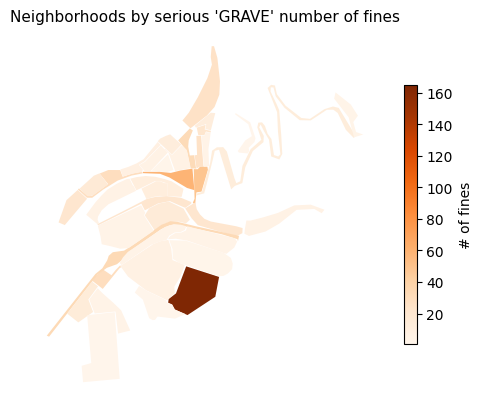
Fines by year#
QUESTION: How have the number of fines evolved during the last few years?
Show code cell source
# Group by year and fine category, then sum up fines
fines_years = fines.groupby(["year", "category"])["fines"].sum().unstack()
# Rearrange column order: LEVE, GRAVE, MUY GRAVE
fines_years = fines_years.iloc[:, [1, 0, 2]]
# Create new column with the total amount of fines: LEVE + GRAVE + MUY GRAVE
fines_years["total"] = fines_years.sum(axis=1)
print(fines_years)
category LEVE GRAVE MUY GRAVE total
year
2018 1112 194 4 1310
2019 583 104 2 689
2020 1183 95 1 1279
2021 918 167 11 1096
2022 1604 158 11 1773
Show code cell source
# Plot
fig, ax = plt.subplots(figsize=(6, 4))
fines_years.drop(["total"], axis=1).plot(ax=ax, kind="bar",
stacked=True, color=palette)
ax.grid(axis="y")
ax.set_axisbelow(True)
ax.tick_params(axis='x', labelsize=12, rotation=0)
ax.tick_params(axis='y', labelsize=12)
ax.set_title("Number of fines", fontsize=12)
ax.set_xlabel("", fontsize=12)
ax.set_ylabel("# of fines", fontsize=12)
ax.legend(bbox_to_anchor=(1.0, 0.5), loc='center left', fontsize=10)
sns.despine()
plt.show()
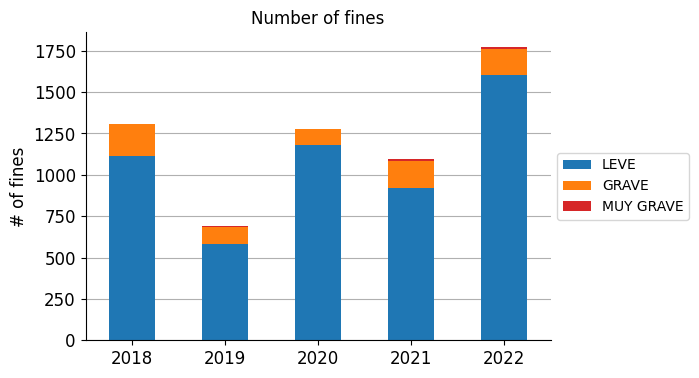
Fines by year and street#
QUESTION: How have the number of fines evolved during the last years in the top 10 fine-prone streets?
Show code cell source
# Group by year, street and fine category, then sum up fines
fines_years_streets = fines.groupby(["year", "street", "category"])["fines"].sum().unstack()
# Rearrange column order: LEVE, GRAVE, MUY GRAVE
fines_years_streets = fines_years_streets.iloc[:, [1, 0, 2]]
# Create new column with the total amount of fines
fines_years_streets["total"] = fines_years_streets.sum(axis=1)
print(fines_years_streets)
category LEVE GRAVE MUY GRAVE total
year street
2018 ANTIO 9.0 3.0 NaN 12.0
ANTONINO ORAA KALEA 1.0 1.0 NaN 2.0
ARGIXAO AUZOA 1.0 NaN NaN 1.0
ARTIZ AUZOA 24.0 1.0 NaN 25.0
BELOKI HIRIBIDEA 12.0 3.0 NaN 15.0
... ... ... ... ...
2022 SORALUCE KALEA 6.0 NaN NaN 6.0
TXURRUKA KALEA 43.0 1.0 1.0 45.0
URDANETA HIRIBIDEA 62.0 5.0 NaN 67.0
UROLA KALEA 9.0 1.0 NaN 10.0
ZELAI-ARIZTI PARKEA 209.0 1.0 NaN 210.0
[189 rows x 4 columns]
Show code cell source
# Create a list with the names of the top 10 fine streets
fines_streets_top10 = fines_streets.iloc[:10].index
# Filter top 10 streets
fines_years_streets = fines_years_streets.reset_index()
fines_years_streets_top10 = fines_years_streets[fines_years_streets["street"]\
.isin(fines_streets_top10)]
# Plot
fig, ax = plt.subplots(figsize=(7.5, 5))
sns.pointplot(ax=ax, x="year", y="total", data=fines_years_streets_top10,
hue="street")
ax.grid(axis="y")
ax.set_axisbelow(True)
ax.tick_params(axis='x', labelsize=14, rotation=0)
ax.tick_params(axis='y', labelsize=14)
ax.set_title("Evolution of fines in top 10 fine-prone streets", fontsize=14)
ax.set_xlabel("", fontsize=13)
ax.set_ylabel("# of fines", fontsize=14)
ax.legend(bbox_to_anchor=(1.0, 0.5), loc='center left', fontsize=12)
sns.despine()
plt.show()
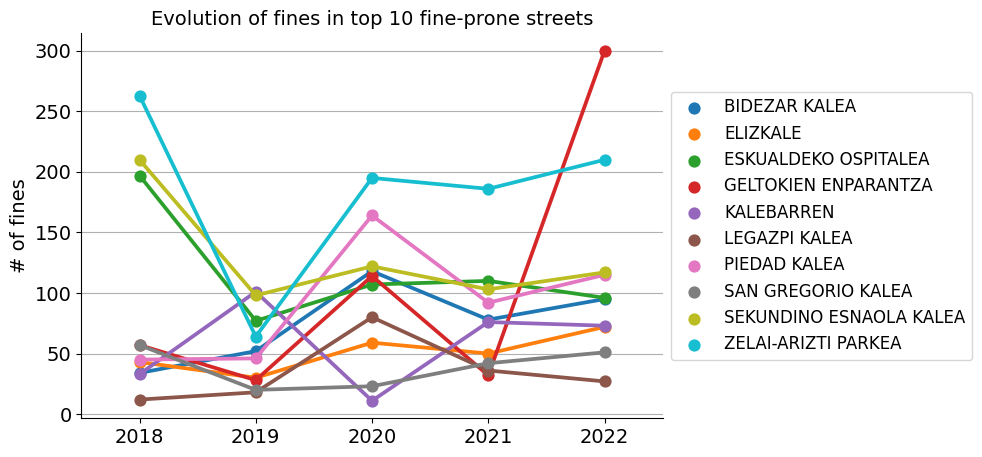
Money collected from fines#
QUESTION: How much money does the municipality collect from fines?
The data comes with two columns related to the amount of money:
“IMPORTE PAGADO”: which I have renamed as “paid”.
“IMPORTE PENDIENTE DE PAGO EN EJECUTIVA”: which I have renamed as “unpaid”.
For the sake of clarity, I have added together both columns (I have supposed pending payments will eventually be processed).
Show code cell source
# Create new column with the total amount
fines["paid_unpaid"] = fines["paid"] + fines["unpaid"]
# Group by year and fine category, then sum up fines
fines_money = fines.groupby(["year", "category"])["paid_unpaid"].sum().unstack()
# Rearrange column order: LEVE, GRAVE, MUY GRAVE
fines_money = fines_money.iloc[:, [1, 0, 2]]
# Create new column with the total amount of money raised
fines_money["total"] = fines_money.sum(axis=1)
print(fines_money)
category LEVE GRAVE MUY GRAVE total
year
2018 19548.05 16623.60 1704.95 37876.60
2019 8359.39 8695.95 500.00 17555.34
2020 11778.40 6099.65 500.00 18378.05
2021 14145.21 14438.45 1134.95 29718.61
2022 27313.80 13633.91 4499.75 45447.46
Show code cell source
# Plot
fig, ax = plt.subplots(figsize=(6, 4))
fines_money.drop(["total"], axis=1).plot(ax=ax, kind="bar",
stacked=True, color=palette)
ax.grid(axis="y")
ax.set_axisbelow(True)
ax.tick_params(axis='x', labelsize=12, rotation=0)
ax.tick_params(axis='y', labelsize=12)
ax.set_title("Revenue from fines", fontsize=12)
ax.set_xlabel("", fontsize=12)
ax.set_ylabel("euros (€)", fontsize=12)
ax.legend(bbox_to_anchor=(1.0, 0.5), loc='center left', fontsize=10)
sns.despine()
plt.show()
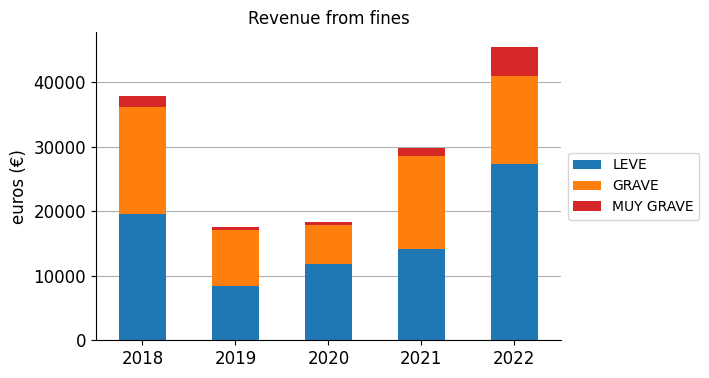
Finally, I find it interesting to summarise this graphic into one single figure: how much money do they collect roughly per year?
Show code cell source
# How much money do they collect on average per year?
avg_year = fines_money["total"].mean()
# The same value roughly
avg_year_rough = round(avg_year, -3)
display(Markdown(f"The amount of money collected per year is roughly **{avg_year_rough:.0f} €**"))
The amount of money collected per year is roughly 30000 €
Conclusions#
This project was about shedding light on a freely available open data set. In this case, I downloaded the files of traffic fines in my town. The analysis consisted in exploring ways of representing the data to get a clear picture of its contents. This kind of work should be useful for the people involved, to watch out for trends and follow up new policies. And for the public, to effectively make the information transparent for all of us.